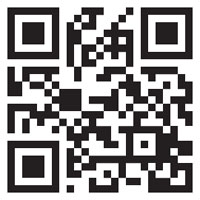 We’ve all seen them, and they’re becoming more heavily integrated into print with the prolific infiltration of smartphones and other mobile devices. But what is it, and how can it be used?
We’ve all seen them, and they’re becoming more heavily integrated into print with the prolific infiltration of smartphones and other mobile devices. But what is it, and how can it be used?
A QR code (abbreviated from Quick Response code) is a type of matrix barcode (or two-dimensional code) first designed for the automotive industry. More recently, the system has become popular outside of industry due to its fast readability and comparatively large storage capacity. The code consists of black modules arranged in a square pattern on a white background. The information encoded can be made up of any kind of data (e.g. binary, alphanumeric, or Kanji symbols).
Thanks again, Wikipedia!
QR codes are typically scanned by smartphones (or other mobile devices such as iPod touch) to direct the reader to a website or perform some other task more easily. For example, the reader can scan the QR code and be directed to your website without the need to actually type in the URL. This is done by using apps installed on the device. Qrafter, for example, is a good one. I prefer RedLaser. Different scanning apps provide different benefits. I like RedLaser because it can scan many different types of codes, including UPC bar codes, which then checks online (and sometimes local) resellers for the lowest price.
Beyond performing a cool, vital function, they also serve as a way to legitimize certain printed materials. I recently created some tickets for a Boy Scout Troop’s Annual Pancake Breakfast Fundraiser. The QR code simply directed the user to the troop’s website, but the purchaser of the ticket would assume it was a unique barcode number. This would inhibit the duplication of tickets and reduce fraud.
QR codes can be used to perform many functions. For example:
| Browse to a Website Bookmark a Website Make a Phone Call Send an SMS Send an E-Mail Create a vCard Create a meCard Create a vCalendar Event Google Maps Bing Maps Geographical Coordinates |
iTunes App URL iTunes App Review URL Android Market Search Foursquare Venue URL Youtube URL for iOS Encode Latest Tweet of a User Tweet on Twitter Twitter Profile Image Overlay Create Blackberry Messenger User WIFI Network for Android Free Formatted Text |
So, now that we know how to scan them, how do we create them? I personally like the generator created by Kerem Erkan. It allows you to export the QR code to many formats, my favorite being vector EPS. This allows me to open the QR code in Illustrator, easily adding it to the client’s artwork.
It’s important to note that all of the data required to perform the action is stored in the QR code itself. No third party website or service stores the code behavior or tells the smartphone what to do. The scanner reads the QR code, decrypts it, then performs the action.
By the way, the QR code at the top of this post actually works. Give it a try. You should be taken to the mobile version of this blog.
This has been today’s Clarified Butter.
